
Olearia axillaris, commonly known as coastal daisy-bush, coast daisy-bush or coastal daisybush is a species of flowering plant in the family Asteraceae and is endemic to coastal areas of Australia. It is an erect, bushy shrub with densely cottony-hairy branchlets, aromatic, linear to narrowly elliptic or narrowly lance-shaped to egg-shaped leaves with the narrower end towards the base and small white and yellow, daisy-like inflorescences.
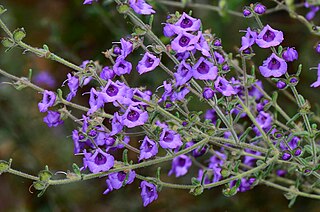
Prostanthera hirtula, commonly known as hairy mintbush, is a species of flowering plant in the family Lamiaceae and is endemic to the south-eastern continental Australia. It is a strongly aromatic, densely hairy, spreading shrub with narrow egg-shaped leaves and dark mauve flowers, and that grows in exposed, rocky sites.

Persoonia brevifolia is a plant in the family Proteaceae and is endemic to a restricted area near the border between south-eastern New South Wales and Victoria. It is an erect shrub with elliptic to egg-shaped leaves and cylindrical yellow flowers arranged singly in leaf axils.

Goodenia amplexans, commonly known as clasping goodenia, is a species of flowering plant in the family Goodeniaceae and endemic to South Australia. It is a small shrub with sticky foliage, egg-shaped to oblong or elliptic, stem-clasping leaves with small teeth on the edges, racemes of yellow flowers with leaf-like bracteoles at the base, and elliptic fruit.

Goodenia arthrotricha is a species of flowering plant in the family Goodeniaceae and endemic to south-western Western Australia. It is an erect perennial, herb with linear to lance-shaped leaves with the narrower end towards the base, racemes of blue flowers with linear bracteoles at the base, and oval fruit.
Goodenia bicolor is a species of flowering plant in the family Goodeniaceae and is endemic to north-western Australia. It is an annual or ephemeral herb with lance-shaped to egg-shaped leaves with the narrower end towards the base, racemes of yellow or yellow and purple flowers and elliptical fruit.
Goodenia brachypoda is a species of flowering plant in the family Goodeniaceae and is endemic to northern Australia. It is a low-lying to upright herb with narrow elliptic to oblong leaves, racemes of yellow flowers with leaf-like bracts at the base, and more or less spherical fruit.
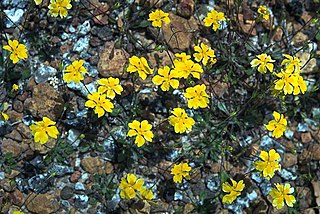
Goodenia claytoniacea is a species of flowering plant in the family Goodeniaceae and is endemic to the south-west of Western Australia. It is an annual herb with lance-shaped leaves mostly at the base of the plant, yellow flowers arranged singly or in small groups, and oval fruit.
Goodenia dyeri is a species of flowering plant in the family Goodeniaceae and is endemic to the south-west of Western Australia. It is an ascending herb with egg-shaped, toothed leaves at the base of the plant, with solitary yellow flowers in the leaf axils.
Goodenia leptoclada, commonly known as thin-stemmed goodenia, is a species of flowering plant in the family Goodeniaceae and is endemic to the extreme south-west of Western Australia. It is an ascending perennial herb with lance-shaped to egg-shaped leaves with the narrower end towards the base and racemes of blue flowers.
Goodenia suffrutescens is a species of flowering plant in the family Goodeniaceae and is endemic to inland areas of north-eastern Western Australia. It is an undershrub with low-lying branches, toothed, lance-shaped to egg-shaped leaves with the narrower end towards the base, and thyrses of blue flowers.
Goodenia viridula is a species of flowering plant in the family Goodeniaceae and is endemic to a restricted area of Queensland. It is an erect undershrub with linear leaves and spikes of greenish yellow flowers.
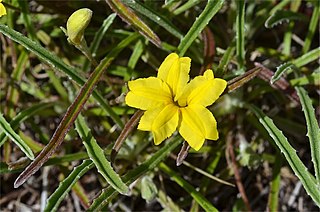
Goodenia willisiana, commonly known as sandhill goodenia, is a species of flowering plant in the family Goodeniaceae and is endemic to drier areas of south-eastern Australia. It is an erect or ascending perennial herb with crowded elliptic to lance-shaped leaves at the base of the plant, and yellow flowers arranged singly in leaf axils.
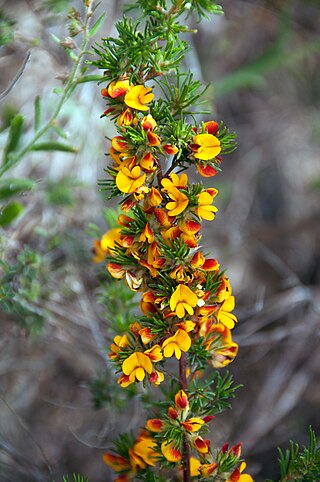
Pultenaea acerosa, commonly known as bristly bush-pea, is a species of flowering plant in the family Fabaceae and is endemic to south-eastern continental Australia. It is a rigid, much-branched shrub with glabrous, grooved, needle-shaped leaves and yellow flowers with red veins.

Pultenaea reflexifolia, commonly known as wombat bush-pea, is a species of flowering plant in the family Fabaceae and is endemic to isolated parts of Victoria. It is an erect shrub with its foliage covered with tangled hairs, and has elliptic to narrow egg-shaped leaves with the narrower end towards the base, and yellow and red pea-like flowers arranged singly or in pairs on the ends of short side branches.

Epacris acuminata , commonly known as claspleaf heath, is a species of flowering plant in the heath family Ericaceae and is endemic to Tasmania. It is a small, spreading shrub with egg-shaped, stem-clasping leaves and tube-shaped flowers with white petals.
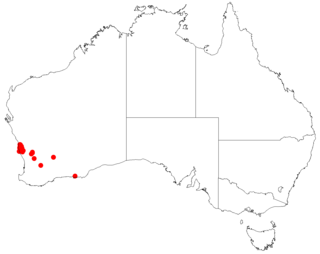
Leucopogon crassiflorus is a species of flowering plant in the heath family Ericaceae and is endemic to the south-west of Western Australia. It is an erect shrub with few branches and that typically grows to a height of 30–60 cm (12–24 in). Its leaves are broadly egg-shaped with the narrower end towards the base, to more or less round, 2–3 mm (0.079–0.118 in) long with a stem-clasping base. The flowers are borne singly or in pairs in upper leaf axils on a short peduncle, sometimes in small clusters, and with small bracts and bracteoles at the base. The sepals are about 4 mm (0.16 in) long and the petals about 6.5 mm (0.26 in) long, the petal lobes longer than the petal tube.

Leucopogon ruscifolius is a species of flowering plant in the heath family Ericaceae and is endemic to north Queensland. It is a shrub with oblong to broadly egg-shaped leaves, the narrower end towards the base, and white, tube-shaped flowers usually arranged singly or in pairs in leaf axils.

Leucopogon strictus is a species of flowering plant in the heath family Ericaceae and is endemic to the southwest of Western Australia. It is an erect, rigid, more or less glabrous shrub with oblong to lance-shaped leaves and white, tube-shaped flower arranged singly or in pairs in leaf axils.

Leucopogon strongylophyllus is a species of flowering plant in the heath family Ericaceae and is endemic to the southwest of Western Australia. It is an erect shrub with crowded egg-shaped or round leaves and white, tube-shaped flower arranged singly or in pairs in leaf axils.














